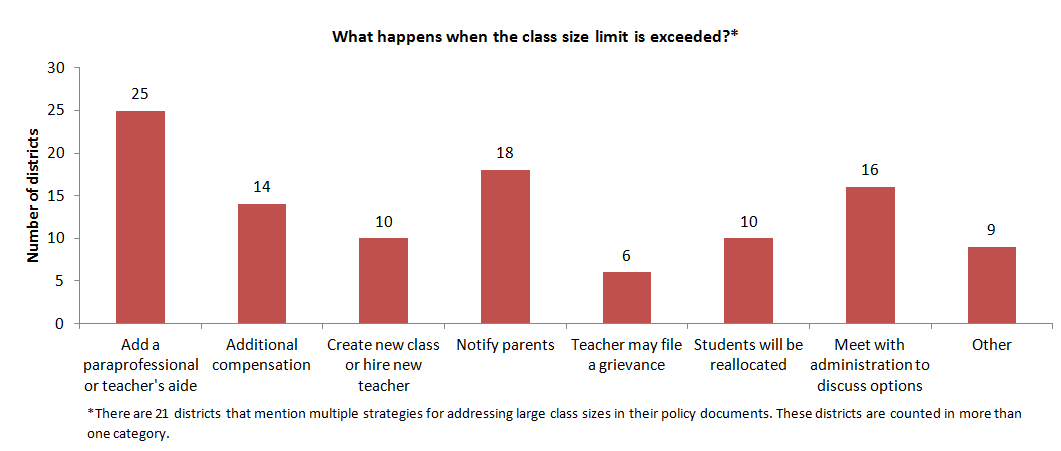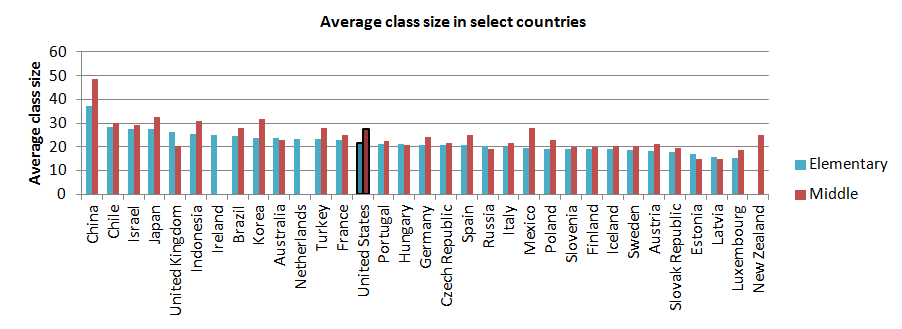District Trendline, previously known as Teacher Trendline, provides actionable research to improve district personnel policies that will strengthen the teacher workforce. Want evidence-based guidance on policies and practices that will enhance your ability to recruit, develop, and retain great teachers delivered right to your inbox each month? Subscribe here.
Class size is always a hot topic, especially among parents
and teachers.
According to the National
Center for Education Statistics
, in the 2011-2012 school year, average
class size across all public schools in the United States was 21.6 students in
elementary school, 25.5 students in middle school, and 24.2 students in high
school. This month, Teacher Trendline looks at class size restrictions and what
happens when class size limits are exceeded.
Class size
restrictions
Among the 149 districts in the database, 102 explicitly
mention some form of class size restriction in collective bargaining agreements
or board policies. The majority of these set absolute or targeted maximum class
sizes, although the language often excludes some grades. Among the districts
that do set limits, a little over half (57 districts) have limits for all
grades from kindergarten through grade 12.
When districts limit class size, on average they set the
limit of about 20 students in pre-kindergarten.
At the secondary level, the limit is much higher at an average of about
31 students in a 12th grade class.
[1]

The table above doesn’t include districts that aren’t
mandating or suggesting a cap to class sizes but try to control class sizes in
other ways, such as defining the average class size or setting school- or
district-wide student to teacher ratios. These policies give districts more
flexibility in staffing decisions. In
Mesa (AZ), for example, the goal
for the average K-3 class size at each school is 26 students.
Districts are much less apt to set limits for secondary
grades than elementary grades. While 92 districts set limits for kindergarten,
only 60 districts set them for 12
th grade, generally expressing more
flexibility about class sizes for older students. For example,
Buffalo and Jefferson County (CO) limit
secondary class size by specifying a limit on the number of students taught
throughout the day (120 to 150 students in Buffalo, 150 students in Jefferson
County).
When districts do set class size limits in secondary grades,
it’s not uncommon for these limits to vary depending on the subject being
taught. Fourteen districts reference different class size limits for academic
or core classes and non-academic classes or electives. For example, in
secondary grades in
Cincinnati, academic classes are
capped at 30 students while elective classes are capped at 34 students.
There are six districts that vary class size restrictions
based on the demographics of the students in the school. In
New York City, class sizes are
smaller in middle school grades in Title I schools.
St. Paul has lower class sizes in
all grades for high-poverty schools.
Minneapolis only specifies class
size maximums for high-poverty schools. Several California districts, including
Los Angeles, Sacramento, and Oakland, also set lower class size
restrictions for high poverty schools.
Four districts (Montgomery County (MD), Baltimore City, Philadelphia, and Greenville County (SC)) are
particularly flexible, allowing class size to vary each year depending upon budget
and student needs.
Exceeding class size
limits
Even with the best of intentions, sometimes districts
exceed class size restrictions
. In fact, it is not unusual to see language
in class size policies referencing class size “targets” or “goals”
(as opposed to fixed caps), essentially statements that the district will make
an effort to meet the goals outlined in the policy, but if it is necessary to
exceed the target, a school has permission to do so. While half of the districts are silent as to
consequences when targets are exceeded, half (72 of 149) do spell out what the
consequences must be.
The most common consequence is that the school must add a
paraprofessional or teacher’s aide to the class. Contracts also often stipulate
that parents must be notified as well as holding a meeting between the teacher and
the administration to discuss solutions.

There are several districts, counted in the “Other” category
above, that explicitly say that the class size limit must be kept at any cost.
In
Long Beach, a return to the cap is
required within 20 days. In
Santa Ana (CA), the district must
correct a K-3 class size variance within three weeks. In
Columbus (OH), the district must
reduce the class size, unless the teacher agrees to exceed the limit. Other
districts in this category have policies to reduce teachers’ non-teaching
duties (
Boston, Minneapolis) or give teachers
additional preparation time (
Santa Ana, Chicago, Minneapolis).
In districts that offer compensation to teachers for
exceeding class size limits, the amount of compensation is usually determined
by a formula that involves a rate of pay per student over the limit for a given
amount of time. For example, in
Santa Ana intermediate and high
school teachers make $10 per student over the limit per day. Other districts have
greater variation. In
Corona-Norco (CA), teachers in
grades K-8 received $500 per semester while teachers in secondary grades
receive either $600 or $1000 per semester depending on the number of students
over the daily student limit. In
Toledo, teachers receive $125 per
student per instructional hour in elementary grades or per period in secondary
grades.
There are six districts with policies that allow teachers to
address their class size concerns, even though their contracts do not actually
specify the size of classes.
Prince George’s County(MD) and Bismarck (ND) describe only in
general terms that the district will take action if class sizes are deemed to
be a problem, but in
Portland (OR), Christina (DE), Red Clay (DE), and Alpine (UT), teachers are directed
to appeal a class size problem to their supervisors.
An international
comparison
The Organization for Economic Cooperation and Development
gathers data on a variety of education-related topics, including
average
class size
, for its member countries. The graph below shows how class sizes
in the U.S. compare to those of 32 other countries. I
n elementary
grades, the U.S. has a slightly lower than average elementary class size across
these countries. The international average elementary class size is 21.95 while
the average elementary class size in the U.S. is 21.5. In middle school, the
U.S. average class size is 27.6, roughly three students higher than the
international average of 24.3.

Access all of our data on class size policies and more by
visiting the
Teacher
Contract Database
.
|
The Teacher Contract Database includes information on over 145 school |
[1]
In some districts, limits vary by subject or school demographics. In these
cases, we used the limits set for core academic classes and/or schools that
were not high needs or participating in special programs.
